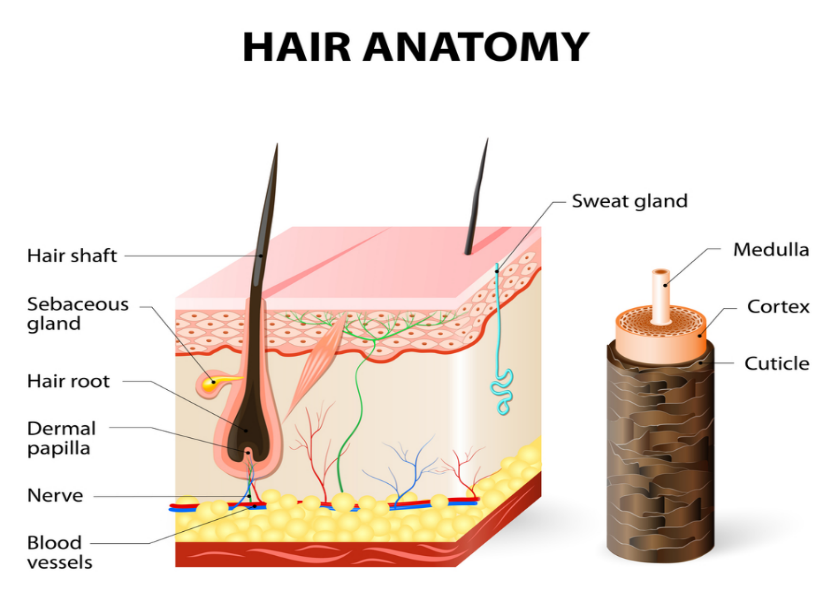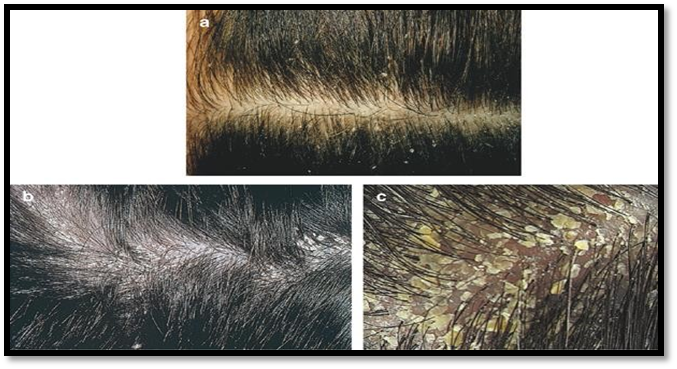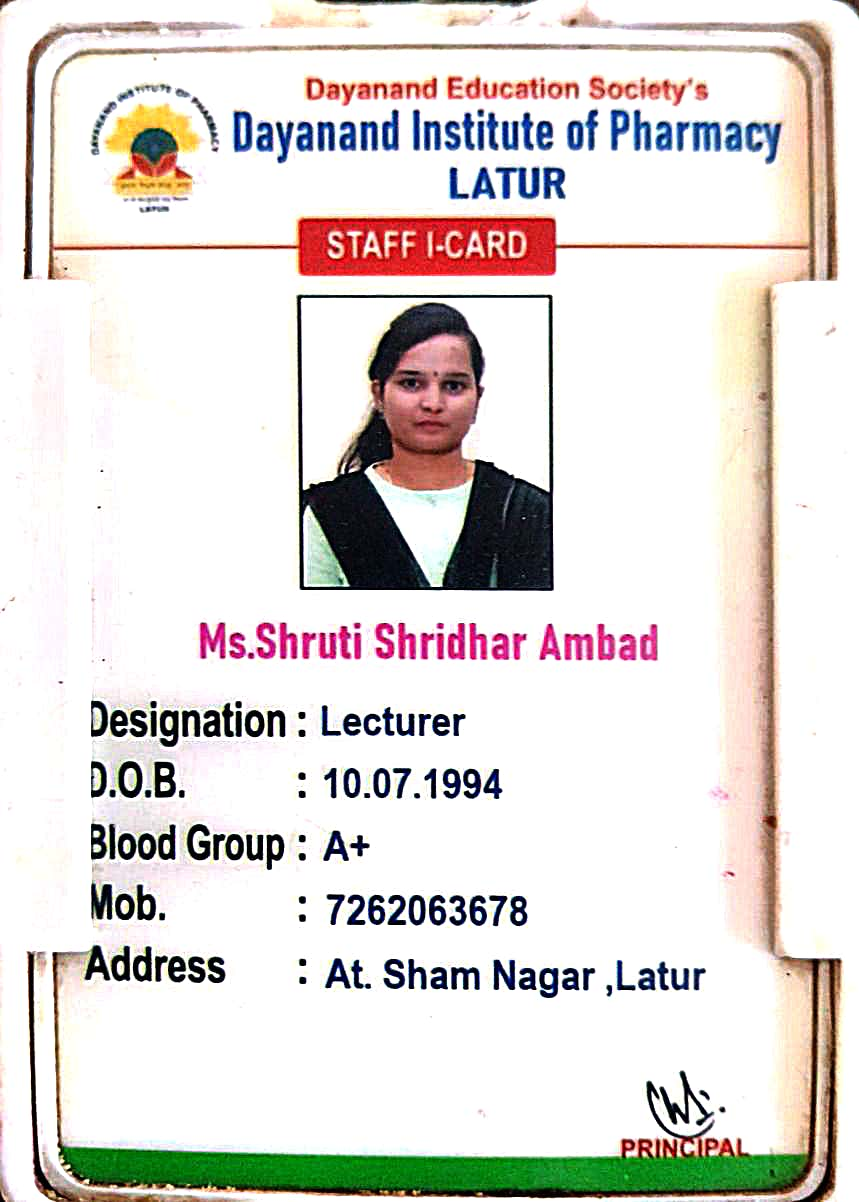Abstract
Dandruff is a common disorder affecting the scalp and can be an embarrassing condition. Now Currently available treatment options have certain limitations, either due to poor efficacies or due to compliance issues. Malassezia furfur is main dandruff pathogen it is lipophilic dimorphic yeast, which is the normal fungal flora of the human skin.Polyherbal hair oils have always attracted considerable attention, when compared to synthetic drugs.The aim of this study to develop a anti-dandruff poly-herbal hair oil that could be used to treat hair issues such as dry or flaky scalp and thinning hair, as well as stimulating hair growth, prevent dandruff, and increase volume to the shaft. The formulated Polyherbal hair oil contains a variety of herbal plants that have traditionally been used to promote hair growth and remove dandruff.
Keywords
Dandruff, Polyherbal, Malassezia furfur, Antifungal.
Introduction
Poly herbal formulation is one of the branch in traditional and alternative medicine which is practiced very commonly in the developing and developed countries. A poly herbal formulation is the combination of more than two to three plants at a definite ratio. It is known that plants have different phytoconstituents which are responsible for the various curable properties that are attributed to them and when a combination of plants with these constituents are combined together it may show better activity when compared to the individual extract. .Polyherbal hair oil is recommended and is used to treat a variety of hair problems. They stimulate hair growth, remove dandruff and prevent hair loss. Hair oil promotes hair growth while also moisturizinge scalp, resulting in healthy hair. The underlying research deals with the preparation and assessment of polyherbal anti-dandruff formulation containing the goodness of Bhrami ,neem ,Coconut oil , Hibiscus, Castor oil. Hair plays a vital role in human body and it is considered to be protective appendages on the body and accessory structure of the integument along with sebaceous glands, sweat glands and nails. Hair is a thin threadlike epidermal structure of about 0.1mm thick, madeup of keratin, which is developed from a hair follicle located in the dermis. It is usually produced only by mammals and is characteristic of a particular group of animals. Diversified hair and hair follicles are found all over the body except on the palms, soles, glabrous foreskin and the lip vennillion. Hair consists of hair shaft, which is a permanent, superficial portion from the bulge upward and a lower, inferior portion which is the root, where the growth cycles anagen, catagen,and telogen are followed in order to produce new hairs.
Hair is protineous in nature made up of keratin. On chemical investigation hair found to contains oxygen, iron, nitrogen, hydrogen, carbon, sulfur and phosphorous. The amount of these chemicals varies with the age, sex, type and color of hair of an individual. Each strand of hair consists of following:
Medulla (The innermost layer)
It is only present in large thick hairs .It consists of several layers of large, loosely packed keratinized cells which may be polygonal or cuboidal in shape. Fat granules, melanin pigment granules, Intercellular and Intracellular air spaces may be present in the medulla.
Cortex (The middle layer)
The cortex gives strength, color, and texture to the hair. The mass of hair shaft is formed by the cortex. The cortical cells are spindle-shaped keratinized cells which are cemented together to form a compact structure. Pigment hair contains longitudinally arranged melanin granules within the cells of the cortex.
Cuticle (The outermost layer)
The cuticle is thin and the layer having no colour which protect the cortex. It is composed of flat, strong, horney cells. These are interlocked with the cells of innermost hair sheath to support the hair firmly in its follicles. The cuticle also serves to bind the cortical cells together to prevent hair shaft from becoming frayed. Hair with split end is resulted when the cuticle breaks and dislodges.
The cuticle is damaged if proper care of hair is not taken and if it is frequently exposed to corrosive chemical agents.

Fig. No 1: Structure of Hair
Chemistry of Hair
Human hair is composed of almost entirely of keratin a protein that has outstanding properties as below: It is totally insoluble in acids, alkalies, and is insoluble in solvents which can dissolve any other proteins. It is resistant to enzymatic digestions. These outstanding Introduction 8 properties of keratin are attributed to the presence of a comparatively high percentage of cysteine, an amino acid. Keratin fibers are composed of long polypeptides chains, which are connected laterally by various linkages.
- Hair Loss / Hair Disease
Loss of hair is associated with problems in the skin. This has derived researchers to explore promising medicinal plants possessing better hair growth enhancing property Hair loss, dandruff, hirsutism, alopecia areata are the common patient complaints, which are the sources of significant psychological and physical stress . A number of natural hair care products in form of herbal formulations are available in the market, which are used against hair loss as well as other hair related diseases (Olsen 1993). Hair loss is also resulted from various other factors such as aging, genetic pre-disposition, thyroid imbalance, malnutrition or imbalance diet, chronic illness, hormonal effects of contraceptive pills, pregnancy, or menopause, certain medications and radiation therapy /chemotherapy used for treating cancer, etc. People are nowadays spending a good amount towards hair related diseases. Ayurveda has also classified hair diseases into three types:
1.Khalitya means loss of hairs
2.Palitya means premature hair graying.
3.Indralupta means alopecia areata (AA), totalis, univeralis.
It is a common hair problem giving much embarrassment to the affected person. Globally about 5% population mostly between the age groups of 20 and 30 years are affected by dandruff. Usually it occurs during post adolescent period and comparatively affects more male population . The main symptom of dandruff is formation of scale on the scalp and it is frequently associated with seborrhoea. Seborrhea is the precursor of seborrheic dermatitis .Dandruff is caused by the yeast Pityrosporum ovale, which feeds on the lipids and proteins found in skin. This initiates the enzymatic activity and releases pro- inflammatory free fatty acids causing tissue destruction and inflammation on skin.
Two types of dandruff are found. One is the dry type which contains grayish white flakes. These flakes shed when the scalp is scratched. Another one is the oily type in which flakes stick to the nails when the scalp is scratched,
- Dry and flaky type (Pityriasis scale)
During winters when the air is dry, and there is little or no sebum, then Pityriasis scale will appear due to drying of the outer layer of the skin i.e., (the stratum corneum
- Oily-type (Seborrhoeic scale)
Seborrhoeic scales appear due to excessive sebaceous secretion, generally during the time of summers and rainy season when the climate is humid. Sebaceous secretion is also excessive due to excess androgenic hormone and Keratinization. Keratinization phenomenon was accelerated by physical irritation or chemical irritation. Physical irritation includes scratching with the nails, excessive combing or use of hair dryers; Chemical irritation may occur from drugs.

Fig No. 2: Dandruff
Cause of Dandruff
Fungal: Malassezia furfur is considered as the leading cause of dandruff. The fungi - Malassezia can lead to dandruff by either or both of the following mechanisms-
Malassezia stimulates the enzyme called Lipase on the scalp. The enzyme causes oxidation of triglycerides of sebum to produce unsaturated and saturated fatty acids. Saturated fatty acids are consumed by the fungi for self- proliferation and growth. Unsaturated fatty acids include oleic acid and arachidonic acid. Oleic acid is an irritant for human skin while arachidonic acid is involved in potentiating the inflammatory responses. Hence the result of the degradation of the fatty acids is scalp skin irritation, inflammation and fungal growth. The other mechanism by which this fungi causes dandruff is altering the normal shedding of dead skin cells. Few enzymes on scalp eat up connections between dead skin cells to slough them individually. Malassezia modifies this function of enzymes and inhibits cutting of the connections.This leads to aggregation of corneocytes that shed off in clusters, leading to visible white flakes. More than seven species of Malassezia has been reported i.e. M. sympodialis, M. globa, M.sympodialis, M.furfur, M. obtuse, M. sloofiae, M. restricta, M. pachydermatis. Multiple lipid- dependent species are (including M. globosa, M. Restricta, M.furfur, M. obtusa, M. japonica, M. nana,dermatitis, and M. yamatoensis), &non.lipid-dependent, primarily zoophilic, species, M. pachydermatis. To overcome these problems, As a hair tonic,polyherbal hair oil containing herbal medicines is used. Hair tonic s and hair grooming aids are the two major categories of hair care products. In India preparation of hair oils blended with various hair growth promoting drugs is an age old process. In many old literatures hair tonic preparations are included to treat various dandruff and hair fall process. The hair oil preparations are mainly intended to cool the scalp and for luxurious growth of hair in women. Various types of oils like coconut oil, mustard oil, castor oil, olive oil are applied to scalp in admixture with suitable herbal drugs Of all these coconut oil is the best suitable oil base due to its effective activity and also economical compared to other oils. Polyherbal hair oil is recommended and is used to treat a variety of hair problems. They stimulate hair growth, enhance hair charm, and remove dandruff. Hair oil promotes hair growth while also moisturising the scalp, resulting in healthy hair. The goal of this study was to prepare and evaluate a polyherbal hair oil with herbs such asNeem, brahmi, hibascus ,castor oil in coconut oil. Many of these herbs have a long history of use in the treatment of hair problems.
Role of Herbs in Polyherbal Hair oil:
Table No. 1: List of Ingredients with uses
|
Sr. No
|
Name of Drug
|
Biological Name
|
Uses
|
|
1
|
Neem
|
(Azadirachta Indica)
|
Promote Healthy Hair Growth. Reduce Dandruff. Treat fungus Growth.
|
|
2
|
Brahmi
|
(Bacopa Monnieri)
|
Hair Growth
|
|
3
|
Hibascus
|
(Hibiscus Rosa-Sinensis)
|
Antidandruff
|
|
4
|
Castor Oil
|
Ricinus Communis
|
Moisturizer.
|
|
5
|
Coconut Oil
|
(Cocos Nucifera L.)
|
Moisturizer, Vehicle.
|
-
Methods used for preparation
The polyherbal hair oil is prepared by the following mentione processes.
· Cloth method
· Paste method
· Direct boiling method
i) Cloth method:
The dried drug was weighed and tied in a muslin cloth. This cloth was then hanged in coconut oil base, with continuous boiling, stirring and finally the oil was filtered.
ii) Paste Method:
Paste method was used where fresh fruit or pulp or the desired part of the plants were converted into paste with very little amount of water and kept overnight After this the wetted drug was mixed in coconut oil base and boiled with continuous stirring at a constant temperature, until the water droplets in oil stop knocking and the drug has completely extracted in the oil. The Oil was then filtered through a muslin cloth.
iii) Direct Boiling Method:
The crude drugs were powdered, weighed and directly boiled in coconut oil with continuous stirring and heating until the drug had completely extracted in the oil base.
- Evaluation of Polyherbal hair oil preparations
The prepared polyherbal oils were subjected to to evaluate the general characters like colour and odour were evaluated manually. The physical evaluation parameters were determined are specific gravity, pH, viscosity, refractive index, acid value and saponification value.
1] Organoleptic Property
Color, physical state, and odour were manually determined for various organoleptic properties.
2] pH
A pH metre was used to examine the pH of poly-herbal hair oil.
3] Viscosity
It is a calculation of a liquid's resistance to flow; the higher the viscosity, the greater the resistance to flow. Ostwald's viscometer was used to evaluate the viscosity.
4] Refractive index
Using a refractometer, it was determined.
5] Specific gravity
Initially empty specific gravity bottle was weighed. Then the same specific gravity bottle was filled with water and again weighed. Later specific gravity bottle was replaced with hair tonic and weighed again. Weights are noted and thus specific gravity of hair tonic was calculated. Weight of empty specific gravity bottle = w1gms.
Weight of specific gravity bottle with water = w2gms.
Weight of specific gravity bottle with hair tonic = w3gms.
Specific gravity bottle of water = 0.9961 g/cm3.
Specific gravity of hair tonic was calculated as ?= w3-w1/w2-W1x?
6] Acid value
Preparation of 0.1 molar solution Weighing 0.56 g KOH pellets and dissolved it in 100 mL distilled water while being constantly stirred The prepared 0.1 molar KOH solution was poured into the burette. Preparation of sample 10 ml of oil were taken and dissolved in 50 ml of a 1:1 ethanol/ether mixture that was vigorously shaken. Then 1 mL phenolphthalein solution was added, and it was titrated with a 0.1 molar KOH solution.
Acid value was calculated from the following equation.
Acid value = 5.61 x n/w
7] Saponification value
In a 250 mL conical flask, 1 mL of oil was correctly measured, and 10 mL of ethanol:ether mixture (2:1) was added. 25 mL of 0.5 N alcoholic KOH was mixed to this flask. The flask was held for 30 minutes and then cooled. Using phenolphthalein indicator, 0.5 N HCl was used to titrate the cooled solution.Amount of KOH in mg consumed was calculated as below.
Saponification Value = 28.05*(X-Z)/W.
The formulated Poly herbal hair oil was subjected to evaluate the anti-dandruff activity against M. furfur by agar well diffusion and broth dilution assay.
1.Well diffusion assay
Isolates from the dandruff was inoculated by swabbing on the surface of gelled media plates. Wells of 6 mm in diameter was performed in the PDA media, and each well filled with 50 ?l of various concentrations of poly herbal hair oil. The plates were kept in laminar air flow for 30 minutes for proper diffusion of the extract and thereafter incubated at 37º C for 3 - 5 days. The radius for the zone of inhibition was measured in millimeters and recorded against the corresponding concentration.
2. Broth dilution assay
Broth dilution assays are standard method used to compare the inhibition efficiency of the anti-dandruff agents. 5 ml of the potato dextrose broth, 0.1 ml of the culture (grown for 24 hrs) and the poly herbal hair oil was added in the culture tubes. The tubes were incubated at 37º C for 24 h. The optical densities were measured spectrometically at 600 nm.
This review gives knowledge about detail chemistry hairs with its problems and also provides their solutions. Neem extract was evaluated for physicochemical by using different organic solvents. Dandruff is a dermatological condition /disease which don’t have serious threat to life but can lead to embarrassing situations and negative social image. Dandruff seems grayish white flakes visible on skin or hair and shoulders. Severity varies from person to person. Study highlights on testing of polyherbal oil rather than organic against the M.furfur. The aim of this preparation was to reduce level of M.furfur. In conclusion, oil is beneficial to prevent hair dandruff and loss caused by pollution and dull hair.
REFRENCES
- Sonali Gurav , Sharad Kamble. “Design & Development of Herbal Hair Oil by direct boiling method”. Journal of Drug Design and Research. 2021; 8(3): 1088.
- M. Narshana, P. Ravikumar,An Overview Of Dandruff And Novel Formulations As A Treatment Strategy. IJPSR, 2018; 9(2): 417- 431.
- B. Ramya Kuber, Ch. Lavanya, Ch.Naga Haritha, S. Preethi, G. Rosa. Preparation and evaluation of poly herbal hair oil. Journal of Drug Delivery & Therapeutics. 2019; 9(1):68-73.
- X. Fatima Grace, S. Rahul Raj, S. Shanmughanathan, D. Chamundeeshwari.
- “Preparation And Evaluation Of Polyherbal Hair Oil”. International Journal of Pharmaceutical Chemistry and Analysis. 2014;Vol.1(I): 2394-2789.
- HarshaliWadekar ,RizwanThara. Preparation and Evaluation of Herbal Hair Oil. International Journal of Science and Research . 2020; Volume 9 Issue 11: 2319-7064.
- Ranganathan, S. and Shobana, S., Evaluation of a herbal hair oil in reducing hair fall inhuman volunteers, Indian Drugs, 45[6], June 2008, 451-455.
- K.Sudheer Kumar, S.Gomathi, S.SeetarmSwamy Formulation and Evaluation of Poly Herbal Hair Oil .An Economical Cosmenternational Journal Of Advanced Research In Medical & Pharmaceutical Sciences. 2016; 1(2): 2455-6998.
- Sathishkumar P. " Evaluation of Anti-Dandruff Activity of Poly Herbal Hair Oil against The Fungus Malassezia Furfur." IOSR Journal of Biotechnology and Biochemistry (IOSR-JBB) 5.1 (2019): 01-06.
- Mahavir Chhajed, Pritesh Paliwal and Sumeet Dwivedi Formulation Development and Evaluation of Poly Herbal Hair Oil for Hair Growth Stimulating Activity International Journal of Pharmacy & Life Sciences 2020 11(6):6675-6682.
- N. Sanju, N. Arun and K. K. Roop, Cosmetic Technology, 1st Edition, Birla Publications Pvt. Ltd, Delhi (2006) pp. 379-382.
- Sapna Gautam, Sumeet Dwivedi ,Kushagra Dubey And Hemant Joshi “Formulation And Evaluation Of Herbal Hair Oil”. Int. J. Chem. Sci. 2012 : 10(1), 2319-7064.
- Gueho E., Midgley G. and Guillot J. (1996). The genus Malassezia with description of four new species. Antonie Van Leeuwenhoek; 69: 337 - 55.
- Naga padma P., Anuradha K., Divya K. (2015). Comparison of potency of antifungal action of dandruff shampoos and different plant extracts. International Journal of Medical Research and Health Sciences, 4 (2): 327 – 331.
- Krishnamoorthy JR, Ranganathan S, Shankar SG, Ranjith MS. Dano: A herbal solution for dandruff. African J Biotechnol.2006;5(10):960–2.
- Pramodani MPN, Wickramarachchi WJ. A clinical study to evaluate the efficacy of selected traditional hair pack for dandruff. Int J Res. 2017;5(1):12–21.
- Pisal S, Mane V. Studies on Antifungal activities of certain plant extracts against dandruff-causing fungus, Malassezia. Int J Curr Res Biosci Plant Biol. 2015;7:206-11
- Prabhamanju M, Shankar SG, Babu K. Herbal vs. chemical actives as antidandruff ingredients -Which are more effective in the management of dandruff?– An overview.


 Ambad Shruti S.*
Ambad Shruti S.*
 Dr. Chaus W. N.
Dr. Chaus W. N.
 Panchal Sushma G.
Panchal Sushma G.


 10.5281/zenodo.14893305
10.5281/zenodo.14893305